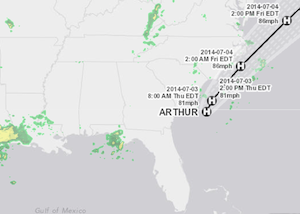HONOLULU — As the first tropical storm to hit Hawaii in 22 years passed by the islands, some coffee farmers on the Big Island began navigating flooded roads to assess damage to their crops Friday while tourists wandered the beaches of Oahu and surfers took to the waves despite driving rain and wind.
The first of two storms in the area reached shore overnight Friday as a weakened tropical storm. A second system close behind it also weakened and was on track to pass north of the Hawaiian islands by several hundred miles Sunday.
Tropical Storm Iselle temporarily knocked out power, caused flooding and downed trees when it crossed onto the Big Island. There were no reports of deaths or major injuries, Gov. Neil Abercrombie said Friday.
Those staying in shelters were told to return home, and crews cleared trees from roads, county spokesman Kevin Dayton said.
Heavy rains and wind from the storm’s outer bands hit Maui and Oahu on Friday morning but eased later in the day as Iselle swirled farther out to sea.
The National Weather Service canceled the tropical storm warning for the Big Island, Oahu and Maui on Friday afternoon, but kept it in effect for Kauai.
On Oahu’s south shore, near Honolulu, the cloudy skies started to give way to patches of blue as tourists and residents ventured out to see the surf.
“We’ve never seen the water crash into the rocks the way they are. It’s just beautiful,” said Army Sgt. Steven Reyes, who drove to the coast with his mother after his home on a central-Oahu Army base lost power.
Honolulu’s lifeguard division said about a dozen surfers were riding waves Friday at a spot nicknamed “Suicides,” near the popular Diamond Head crater. Lifeguards on Oahu were planning to only respond to emergency calls, avoiding regular patrols.
Back on the Big Island, coffee farmers on the southeastern side tried to get around fallen trees on flooded roads to determine any crop damage, said Randy Stevens, general manager of Kau Coffee Mill.
“It’s raining so hard, we’re just trying to get the roads opened up so we can get to the fields,” Stevens said.
The heavy rain and flooding seen in the southeastern Kau district is vastly different from the relatively drier Kona region on the Big Island’s western side, where much more coffee is grown and the storm had little effect.
“We’re all buttoned up, but nothing happened,” said Bruce Corker, a Kona coffee farmer.
Meanwhile, Hurricane Julio, some 900 miles behind in the Pacific, was downgraded to a Category 2 storm and packed maximum sustained winds of about 105 mph. National Weather Service officials predicted it would continue to weaken on a path that should take it about 200 miles north of the island chain starting sometime Sunday morning.
If Julio stays on track, “the impacts to the islands would be minimal,” Weather Service meteorologist Derek Wroe said. “We would see some large surf. … We could see some heavy showers. That’s all assuming this track holds. Otherwise, we could still see some tropical storm conditions.”
There remains uncertainty given its distance from land.
“We’re not out of the woods yet with Julio,” Wroe said.
Iselle also had weakened, having been downgraded to a tropical storm about 50 miles from shore late Thursday, and within hours, its winds slowed to 60 mph, well below the 74 mph threshold for a hurricane.
Experts said the Big Island’s mountainous terrain helped weaken the storm.
Hawaii has been directly hit by hurricanes or tropical storms only three times since 1950. The last time was in 1992, when Hurricane Iniki killed six people and destroyed more than 1,400 homes in Kauai.
The state prepared for the back-to-back storms by closing government offices, schools and transit services across Hawaii. But today’s primary elections, including congressional and gubernatorial races, will go forward as planned.
Travelers faced disrupted plans several airlines canceled dozens of flights, the Hawaii Tourism Authority said. Some airlines waived reservation change fees and fare differences for passengers who needed to alter their plans.
The storms are rare in Hawaii but not unexpected in El Nino years, a change in ocean temperature that affects weather around the world. Ahead of this year’s hurricane season, weather officials warned the wide swath of the Pacific Ocean that includes Hawaii could see four to seven tropical storms this year.
Information for this article was contributed by Oskar Garcia, Cathy Bussewitz, Manuel Valdes, Karin Stanton and Brian Skoloff of The Associated Press.

